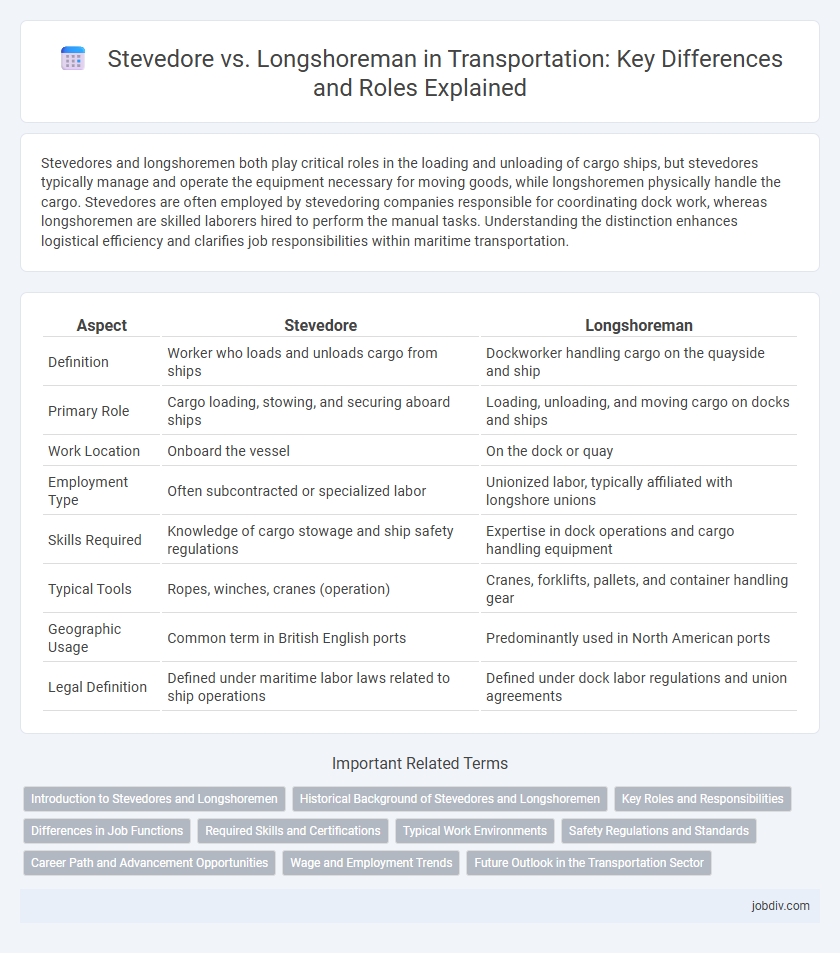Stevedores and longshoremen both play critical roles in the loading and unloading of cargo ships, but stevedores typically manage and operate the equipment necessary for moving goods, while longshoremen physically handle the cargo. Stevedores are often employed by stevedoring companies responsible for coordinating dock work, whereas longshoremen are skilled laborers hired to perform the manual tasks. Understanding the distinction enhances logistical efficiency and clarifies job responsibilities within maritime transportation.
Table of Comparison
| Aspect | Stevedore | Longshoreman |
|---|---|---|
| Definition | Worker who loads and unloads cargo from ships | Dockworker handling cargo on the quayside and ship |
| Primary Role | Cargo loading, stowing, and securing aboard ships | Loading, unloading, and moving cargo on docks and ships |
| Work Location | Onboard the vessel | On the dock or quay |
| Employment Type | Often subcontracted or specialized labor | Unionized labor, typically affiliated with longshore unions |
| Skills Required | Knowledge of cargo stowage and ship safety regulations | Expertise in dock operations and cargo handling equipment |
| Typical Tools | Ropes, winches, cranes (operation) | Cranes, forklifts, pallets, and container handling gear |
| Geographic Usage | Common term in British English ports | Predominantly used in North American ports |
| Legal Definition | Defined under maritime labor laws related to ship operations | Defined under dock labor regulations and union agreements |
Introduction to Stevedores and Longshoremen
Stevedores are skilled workers responsible for loading and unloading cargo from ships, specializing in securing and handling various freight types to ensure safe transport. Longshoremen operate primarily on the docks, managing the movement, stacking, and storage of goods once offloaded, often utilizing heavy machinery such as cranes and forklifts. Both roles are critical in port logistics, facilitating efficient maritime freight transfer and supply chain continuity.
Historical Background of Stevedores and Longshoremen
Stevedores and longshoremen have distinct historical backgrounds rooted in maritime trade and port labor. Stevedores originated in the 17th century, primarily responsible for loading and unloading ships, with a focus on skilled tasks involving cargo handling and securing goods. Longshoremen emerged later as a collective workforce performing broader dockside duties, evolving through labor movements to gain union recognition and improved working conditions in the 19th and 20th centuries.
Key Roles and Responsibilities
Stevedores specialize in the loading and unloading of cargo from ships, operating heavy machinery like cranes and forklifts to ensure efficient vessel turnaround. Longshoremen perform a broader range of dockside duties including cargo handling, securing loads, and coordinating with shipping agents to maintain port logistics. Both roles are critical in maritime transportation, emphasizing teamwork to optimize the flow of goods through ports.
Differences in Job Functions
Stevedores primarily oversee the loading and unloading of cargo from ships, coordinating the placement and securing of goods to ensure safe transport. Longshoremen focus on the physical handling of cargo, including moving, stacking, and organizing shipments on docks and in warehouses. The distinction lies in stevedores managing overall cargo operations and longshoremen executing manual labor for cargo handling.
Required Skills and Certifications
Stevedores require skills in cargo handling, crane operation, and securing loads, often holding certifications like OSHA safety training and forklift operation licenses. Longshoremen must excel in teamwork, heavy equipment operation, and adherence to maritime safety regulations, frequently obtaining certifications such as TWIC (Transportation Worker Identification Credential) and hazardous materials handling. Both roles demand physical stamina, knowledge of port logistics, and compliance with industry-specific safety standards to ensure efficient cargo transfer in transportation hubs.
Typical Work Environments
Stevedores primarily work on docks and port terminals, loading and unloading cargo from ships using cranes and heavy machinery. Longshoremen operate in similar environments but frequently handle the organization and transportation of goods within warehouses and yards adjacent to shipping terminals. Both roles require coordination in busy maritime logistics hubs to ensure efficient cargo movement.
Safety Regulations and Standards
Stevedores and longshoremen are both essential in cargo handling but must adhere to distinct safety regulations governed by OSHA and the International Maritime Organization (IMO). Stevedores, responsible for loading and unloading ships, follow strict protocols for machinery operation, hazardous material handling, and fall protection to prevent workplace injuries. Longshoremen, who manage dockside operations, comply with standards focused on heavy equipment use, ergonomics, and environmental hazard controls to maintain a safe working environment on the docks.
Career Path and Advancement Opportunities
Stevedores typically start their careers with hands-on training in cargo handling and gradually advance to supervisory roles overseeing loading and unloading operations at ports. Longshoremen often begin as entry-level dock workers and can progress to specialized positions such as crane operators or logistics coordinators, benefiting from union-supported training programs. Both careers offer advancement opportunities through gaining certifications, seniority, and technical skills in maritime logistics and port management.
Wage and Employment Trends
Stevedores typically earn higher wages than longshoremen due to their specialized skills in ship loading and unloading, with averages ranging from $25 to $40 per hour compared to $20 to $30 for longshoremen. Employment trends indicate a steady demand for longshoremen driven by port automation, while stevedore positions fluctuate more with international shipping volume. Union representation remains strong for both roles, influencing wage negotiations and job security within the maritime transportation industry.
Future Outlook in the Transportation Sector
Advancements in automation and artificial intelligence are reshaping the roles of stevedores and longshoremen, with increased emphasis on operating sophisticated cargo-handling equipment and managing smart port logistics systems. The integration of Internet of Things (IoT) technologies and real-time data analytics enhances efficiency and safety, positioning longshoremen and stevedores as critical operators within digitalized supply chains. Demand for skilled workers proficient in technology-driven processes will grow, driving workforce upskilling and evolving job descriptions in port and maritime transportation sectors.
Stevedore vs Longshoreman Infographic

 jobdiv.com
jobdiv.com